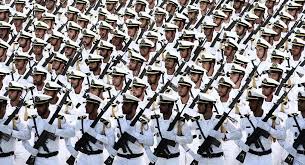Polls Show Reduction Of Soldiers’ Opposition To Gays
New Surveys Examine Shifting Attitudes Among Military and Civilian Populations
SANTA BARBARA, CA — The growing visibility of gays and lesbians in a variety of American institutions has helped to reduce opposition to permitting them to serve in the military, according to scholars and pollsters who study the topic. The release of a new batch of surveys and academic studies offers fresh evidence that Americans’ attitudes toward gay service members are changing.
For the first time, polls now show a majority of Americans in favor of allowing gays to serve *openly* in the military. In a new study to be published this fall by MIT Press, two military sociologists report that 56% of the general public responded affirmatively to a survey asking if they thought gay men and lesbians should be allowed to serve *openly* in the armed forces. Ever since “don’t ask, don’t tell” introduced a distinction between serving openly and serving in the closet, all subsequent polls have shown public support for letting gays serve, but only if they kept their sexual orientation private.
“The military is a reflection of the society it exists to defend,” says Loyola University Chicago Professor John Allen Williams, co-author of the MIT study, “and American society is becoming more tolerant of different lifestyle choices. Sooner or later these changes will filter into the military. They will not be without problems, and it will be up to people of good will to work them out.” The second co-author of the MIT study is UCLA Professor Laura Miller.
In a related trend, anti-gay sentiment within the military has declined over the last decade. A March, 2000 study by Major John W. Bicknell of the Naval Postgraduate School in Monterey, CA found that between 1994 and 1999, the percentage of U.S. Navy officers who “feel uncomfortable in the presence of homosexuals” decreased from 57.8% to 36.4%. According to another poll, since 1992 the percentage of U.S. Army men who “strongly oppose” gays serving in uniform dropped nearly in half, from 67% to 37%. The percentage of army women “strongly opposed” to gay troops fell from 32% to 16%.
Armando Estrada, a psychologist at the University of Texas, measured male Marines’ attitudes toward homosexuals in a 1999 study and found that on a scale of 0 to 100, the Marines’ average score was 47.52. “The specific number is not particularly significant,” says Nathaniel Frank, Director of Communications at the Center for the Study of Sexual Minorities in the Military, “but the larger point is that mild dislike, not hatred, seems to characterize the feelings of the average enlisted Marine about his gay comrades.”
New polling data also indicate that Republicans have demonstrated a growing acceptance of gays and lesbians in the military. Early this summer, the National Gay and Lesbian Task Force released a study by Alan Yang, a political scientist at Columbia University, that analyzed 2000 National Election Survey data. The study, which polled 1,807 adults during the fall of 2000, shows that 65.7% of Republicans now support the right of gays and lesbians to serve in the military, up from the 57% of self-described “conservatives” who favored gay troops in 1996.
Interestingly, according to a May, 2001 Gallup Poll, while a majority of Americans believe that homosexuality is an “acceptable alternative lifestyle,” most Americans have the impression that others find it unacceptable. That is, even those who identify as tolerant of gays and lesbians themselves, believe the rest of the country is not as tolerant. “Given that the primary rationale for the ban on openly gay soldiers is that most military personnel are intolerant of gays,” says Mr. Frank, “these polling data raise serious questions about the motivation and purpose of don’t ask, don’t tell.”
Additional media contact: Nathaniel Frank, CSSMM Director of Communications, (805) 893-5664
